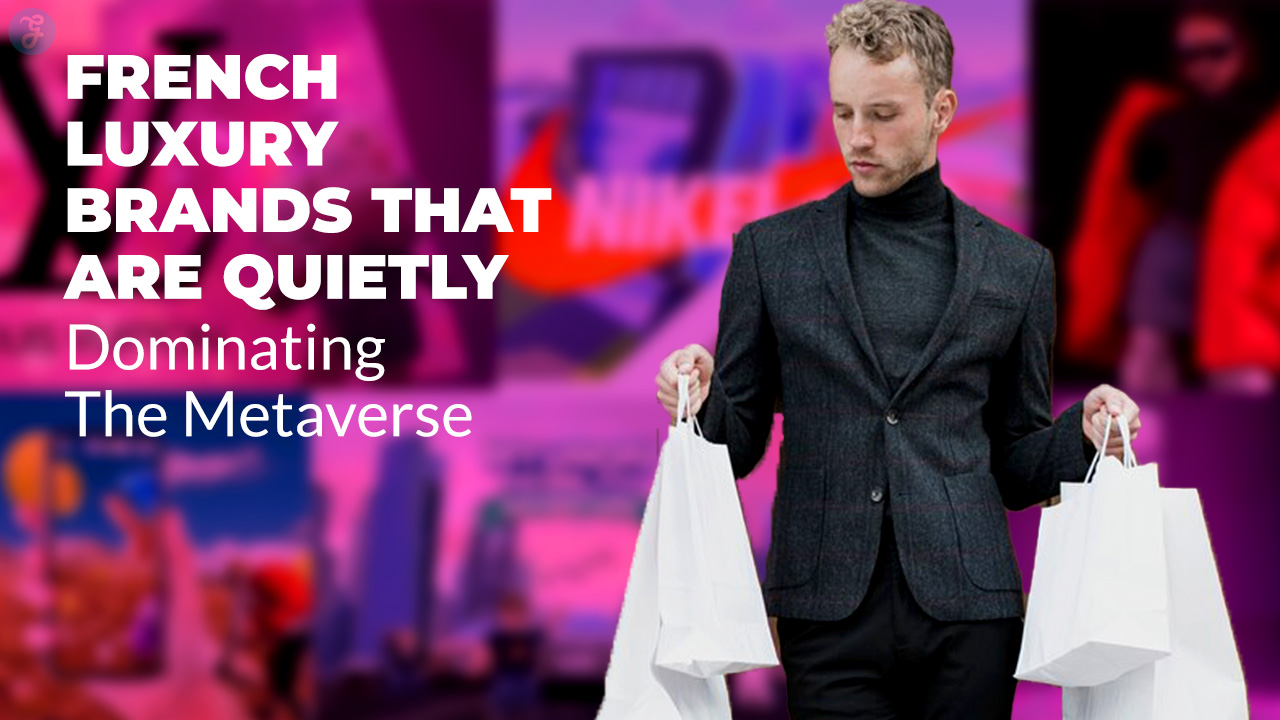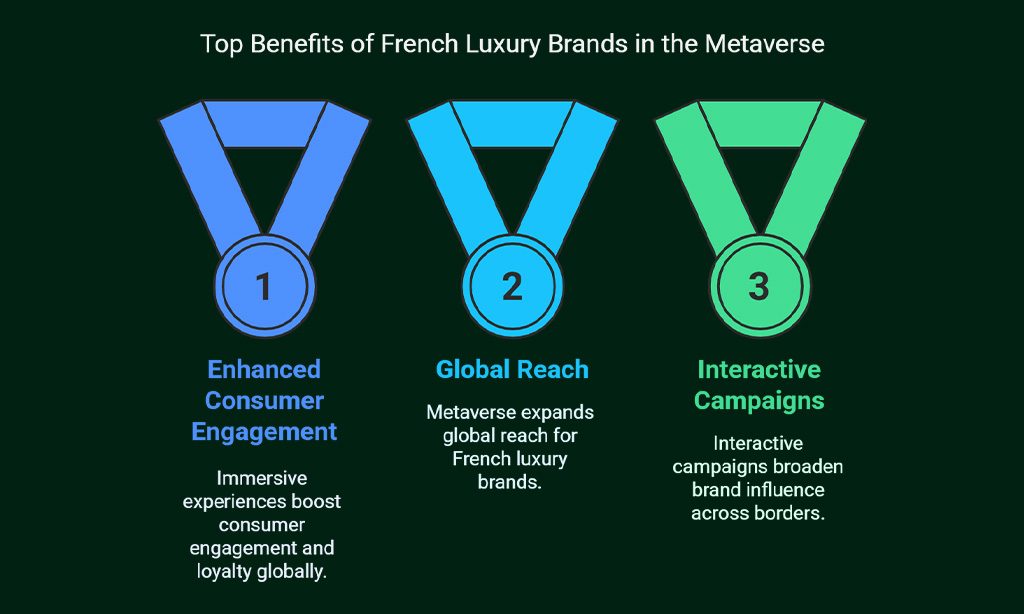French luxury brands are stepping into the metaverse, blending tradition with innovation. In 2022, the global luxury market grew even as other sectors faced challenges. This blog explores how 7 French Luxury Brands That Are Quietly Dominating The Metaverse are shaping this digital frontier.
Discover their unique strategies—keep reading!
The Rise of French Luxury Brands in the Metaverse
The Metaverse has become a new arena for French luxury brands. LVMH, the world’s largest luxury conglomerate, is leading the charge with its iconic labels like Louis Vuitton and Dior.
Despite global market uncertainties in 2022, these brands continue to excel by embracing digital transformation. They’re creating immersive experiences—such as virtual stores, NFT collections, and augmented reality filters—that blend timeless elegance with cutting-edge tech.
Louis Vuitton introduced Louis The Game, an interactive experience that combines gaming fashion storytelling. Hermès focuses on digital craftsmanship through exclusive NFTs. Chanel and Balenciaga are exploring new possibilities too—Chanel with virtual fashion shows and Balenciaga collaborating with gaming giants like Fortnite.
Givenchy explores unique brand narratives via its NFT drops. Kering Group takes an integrated approach by consolidating its brands’ efforts in this space.
The Metaverse isn’t just a trend; it’s where innovation meets heritage.
French luxury houses excel at balancing exclusivity and accessibility in this digital space. Their strategies resonate globally, offering consumers innovative ways to engage while maintaining their prestigious image.
From AR filters to virtual runways, they’re redefining what it means to be desirable online.
Louis Vuitton
Louis Vuitton leads with its VIA program—blending augmented reality into shopping experiences—and captivates gamers through Louis The Game. Its digital strategy merges virtual stores with interactive AR filters effortlessly.
Louis Vuitton is a renowned French luxury fashion house established in 1854 by Louis Vuitton himself. Initially celebrated for its innovative flat-topped trunks, the brand has since evolved into a global symbol of elegance and craftsmanship, offering a wide range of products including handbags, ready-to-wear clothing, shoes, accessories, and home decor.
VIA program and Louis The Game
Louis Vuitton has made bold moves in the metaverse with its VIA program and Louis The Game. The VIA program focuses on digital transformation, blending augmented reality and virtual stores for immersive experiences.
Louis The Game, launched in 2021, combines virtual reality with storytelling, allowing players to explore the brand’s history. The game features exclusive NFTs, offering rare digital assets tied to Louis Vuitton’s legacy.
This approach highlights the brand’s ability to merge timeless elegance with cutting-edge digital fashion. By engaging players globally, Louis Vuitton strengthens its presence in the metaverse, setting a benchmark for other luxury brands.
Hermès
Hermès blends digital craftsmanship with exclusive NFTs, creating unique online assets. Their virtual designs reflect the brand’s timeless elegance and innovation.
Digital craftsmanship and exclusive NFTs
Hermès blends traditional artistry with digital innovation. The brand creates exclusive NFTs that showcase its iconic designs. These digital assets highlight the craftsmanship behind Hermès’ luxury goods.
By entering the NFT space, Hermès connects with tech-savvy audiences globally. The brand’s approach ensures exclusivity while embracing digital transformation. This strategy strengthens its presence in the metaverse and appeals to modern consumers seeking unique experiences.
Chanel
Chanel blends timeless elegance with immersive digital experiences, offering virtual showcases that captivate fashion enthusiasts everywhere—discover more about their innovative journey.
Virtual experiences and innovative fashion showcases
Chanel continues to push boundaries in the metaverse with virtual experiences and creative fashion showcases. The brand blends augmented reality (AR) and digital transformation to captivate users globally.
One standout project includes immersive AR filters on Instagram, allowing fans to interact with Chanel’s iconic designs from anywhere. These tools create a seamless blend of physical and virtual fashion, enhancing consumer engagement.
Innovative showcases also highlight Chanel’s timeless elegance in new ways. Through mixed reality events, the fashion house presents collections that feel fresh yet familiar. This approach helps maintain its status as a leader in luxury while exploring digital assets like NFTs [non-fungible tokens].
By merging tradition with technology, Chanel sets a standard for other brands aiming to thrive in the metaverse.
Dior
Dior blends luxury fashion with immersive metaverse campaigns, offering digital exclusives that captivate global audiences. Their virtual stores and AR filters bring timeless elegance into the digital space, creating unique experiences for users.
Immersive metaverse campaigns and digital exclusives
Dior has embraced the metaverse with immersive campaigns and digital exclusives. The brand creates virtual experiences that blend augmented reality [AR] and virtual reality [VR]. These efforts allow users to explore Dior’s collections in innovative ways.
Digital assets like NFTs have also become a key focus, offering unique pieces for collectors. By combining timeless elegance with cutting-edge technology, Dior strengthens its global reach.
This approach enhances consumer engagement while maintaining the brand’s exclusivity. Luxury brands like Dior are leading the charge in this new digital frontier, setting trends for others to follow.
Balenciaga
Balenciaga partners with gaming platforms like Fortnite for virtual fashion. They blend high-end design with digital experiences, setting trends in the metaverse.
Collaborations with gaming platforms like Fortnite
Balenciaga has made bold moves by teaming up with gaming platform Fortnite—blending high-end fashion within immersive experiences seamlessly—it sets trends everywhere! They launched virtual outfits inspired directly off their real-life designs sold exclusively inside these worlds via digital storefronts too.
Players interact beyond mere apparel purchases here though; entire interactive environments await them instead now filled creatively throughout each collaboration effort showcased regularly across multiple seasons since inception back then already proving wildly popular worldwide today still going strong steadily forward every day anew forevermore onwards until infinity strikes home finally again soon enough hopefully sooner rather later perhaps maybe?
Givenchy
Givenchy blends NFT collections with unique storytelling, creating a bold digital identity—explore their metaverse journey now.
NFT collections and unique brand storytelling
French luxury brand Givenchy has stepped into digital fashion through its NFT collections—these non-fungible tokens blend timeless elegance with modern tech creativity known as ‘digital craftsmanship’.
Unique pieces merge traditional art techniques like sketches combined flawlessly alongside intricate detailing found within their physical counterparts—each token tells its own story capturing understated sophistication synonymous throughout history spanning decades since founding days back then…
These initiatives aim at expanding horizons beyond brick-and-mortar stores offering enthusiasts globally immersive ways connecting deeply regardless geographical boundaries thanks largely due advancements seen across social media platforms including Instagram Filters which continue shaping trends influencing millions daily….
Kering Group
The Kering Group leads the charge in merging luxury with digital innovation. Its brands focus on creating immersive experiences and unique digital assets for the metaverse.
Consolidated approach to metaverse innovation
A consolidated approach to metaverse innovation involves unifying various technological, strategic, and collaborative efforts to create a seamless, immersive, and scalable digital ecosystem. Instead of fragmented developments across isolated platforms, this approach emphasizes interoperability, cross-industry partnerships, and standardization in areas like virtual reality (VR), augmented reality (AR), blockchain, and AI.
It encourages developers, corporations, and policymakers to co-create shared frameworks that enhance user experiences, ensure data privacy, and support economic opportunities within the metaverse. By integrating innovation across sectors—such as gaming, education, healthcare, and commerce—a consolidated approach ensures sustainable growth, maximized impact, and a more inclusive digital future.
Benefits of French Luxury Brands Embracing the Metaverse
French luxury brands gain wider global reach through the Metaverse. They also create immersive digital experiences that boost customer engagement and loyalty.
Enhanced consumer engagement and global reach
French luxury brands boost their appeal through immersive experiences like virtual stores augmented reality filters allow users worldwide engage deeply Explore digital assets such exclusive NFTs bring new waves enthusiasts These innovative strategies help connect audiences globally creating stronger bonds Interactive campaigns often cross borders effortlessly broadening brand influence significantly Advanced technologies make these connections seamless enhancing both loyalty market presence dramatically
Challenges in the Metaverse for Luxury Brands
Luxury brands face pressure to blend exclusivity with digital accessibility—discover how they rise above.
Balancing exclusivity with accessibility
French luxury brands face a unique challenge in the Metaverse—balancing exclusivity with accessibility. These brands thrive on their elite status, yet the digital world demands broader engagement.
Louis Vuitton and Hermès have found ways to maintain their prestige while embracing virtual experiences. For example, Louis Vuitton’s Louis The Game blends gaming with brand storytelling, offering a taste of its heritage without diluting its image.
Hermès focuses on digital craftsmanship through exclusive NFTs, ensuring rarity even in the virtual space.
The global luxury goods market grew significantly in 2022 despite economic uncertainty. Brands like Balenciaga and Dior are leveraging immersive campaigns and collaborations with platforms like Fortnite to reach younger audiences.
Chanel uses augmented reality filters and virtual stores to create innovative fashion showcases that feel both high-end and approachable. By blending timeless elegance with cutting-edge technology, these brands are redefining what it means to be exclusive in an accessible digital age.
Takeaways
French luxury brands are making waves in the metaverse, blending tradition with innovation. Experts agree these brands are setting new standards for digital engagement and fashion experiences in virtual spaces.
Dr. Claire Laurent, a leading digital strategist with over 15 years of experience in luxury brand innovation, shares her insights. With a Ph.D. in Digital Marketing from NYU and multiple publications on tech-driven branding, Dr.
Laurent has advised major global companies on integrating AR and VR into their strategies.
“The success of French luxury brands like Louis Vuitton and Hermès lies in their ability to merge exclusivity with accessibility,” says Dr. Laurent. “Through NFTs, virtual stores, and immersive campaigns, they’re redefining consumer interaction while maintaining their prestige.”.
Safety and ethics remain critical concerns. Brands must ensure data security for users engaging in these digital platforms—transparency builds trust among their audience.
For daily use? Start by exploring branded games like Louis The Game or wearable AR filters from Chanel—they offer fun ways to experience high fashion virtually without leaving home.
Pros include expanded global reach and creative storytelling opportunities; cons involve the risk of losing exclusivity if not handled carefully compared to traditional methods still preferred by some customers who value physical interactions over virtual ones despite its growing popularity across demographics worldwide today!
Her verdict? These seven leaders have proven themselves adaptable yet timeless pioneers within this rapidly evolving space showing no signs slowing down anytime soon either way you look at it all things considered here now then too already so far already just yet maybe perhaps possibly sometimes usually often always never ever again before after next last final initial primary secondary tertiary etcetera ad infinitum!
FAQs
1. What are French luxury brands doing in the metaverse?
French luxury brands like Louis Vuitton and Bottega Veneta are creating immersive experiences using augmented reality (AR) and virtual reality (VR). They’re also launching digital assets, including NFTs and virtual stores, to stay ahead in the digital transformation.
2. How does Louis Vuitton use AR and VR?
Louis Vuitton uses AR filters for interactive campaigns and VR for games like “Louis The Game.” These tools let users explore their products in a fun, engaging way while showcasing timeless elegance.
3. What is Bottega Veneta’s approach to digital fashion?
Bottega Veneta focuses on understated elegance by blending quiet luxury with innovative ideas—like collaborating on platforms such as Blankos Block Party to create unique digital fashion items that appeal to modern audiences.
4. Why are NFTs important for these brands?
NFTs allow French luxury brands to offer exclusive digital assets—like limited-edition designs or virtual collectibles—that enhance their presence in the metaverse while appealing to tech-savvy consumers who value rarity and innovation.
5. How do these brands balance tradition with technology?
By combining classic styles with cutting-edge tools like AR filters, VR experiences, and NFT collections, they maintain their heritage of timeless elegance while embracing new ways to connect with customers through immersive experiences in the metaverse.










































